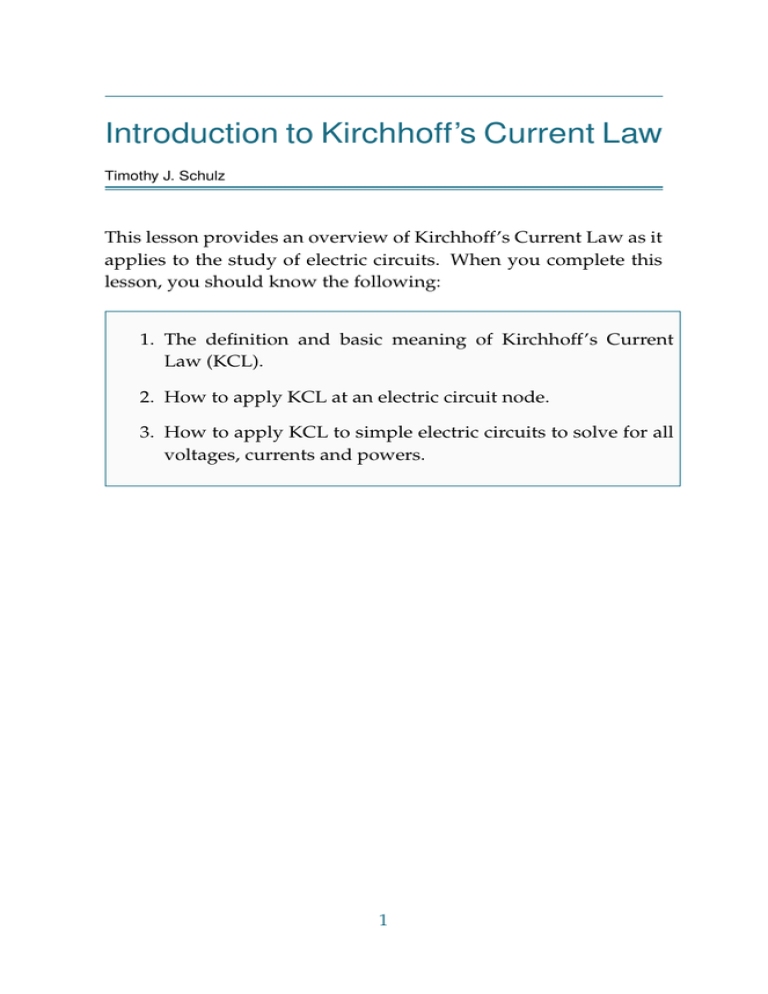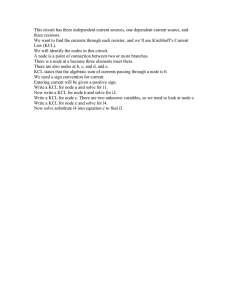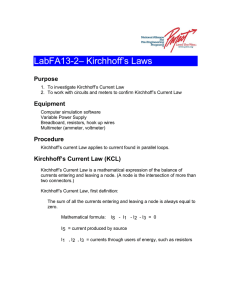Introduction to Kirchhoff`s Current Law
advertisement

Introduction to Kirchhoff’s Current Law Timothy J. Schulz This lesson provides an overview of Kirchhoff’s Current Law as it applies to the study of electric circuits. When you complete this lesson, you should know the following: 1. The definition and basic meaning of Kirchhoff’s Current Law (KCL). 2. How to apply KCL at an electric circuit node. 3. How to apply KCL to simple electric circuits to solve for all voltages, currents and powers. 1 c Timothy J. Schulz Kirchhoff’s Current Law Kirchhoff’s Current Law Simply stated, Kirchhoff’s Current Law (KCL) requires that the sum of all currents out of (or into) a node in an electric circuit must be equal to zero. i3 (t) i4 (t) i2 (t) i1 (t) Applying KCL at the node shown above, for instance, requires that the sum of the currents be equal to zero: i1 (t) + i2 (t) + i3 (t) + i4 (t) = 0. When applying KCL at a node, we need to pay careful attention to the direction of the reference currents. If, for instance, the currents were defined as shown below: i3 (t) i4 (t) i2 (t) i1 (t) then the application of KCL would require that: i1 (t) − i2 (t) − i3 (t) + i4 (t) = 0. Note that the currents defined as flowing into the node—like i2 (t) and i3 (t)—are subtracted from, rather than added to, the KCL sum. 2 c Timothy J. Schulz Kirchhoff’s Current Law Example 1. Suppose we have the following currents specified for a node in a circuit: 1A I −2 A 5A Applying KCL at the node, we require that 5 + (−2) − 1 − I = 0 =⇒ I = 2 A. Example 2. Suppose we have the circuit shown below: B 4i1 10 mA 3 kΩ i1 A If we apply KCL at the node labeled B, we require that the following equation is satisfied: −0.01 − 4i1 + i1 = 0. Therefore, we can determine that the current ii is 3i1 = −0.01 =⇒ i1 = − 3 0.01 10 = − mA. 3 3 c Timothy J. Schulz Kirchhoff’s Current Law Once we know the current i1 , we can use Ohm’s Law to solve for the voltage at node B relative to the voltage at node A: VBA = i1 (3000) = −10 V. Example 3. As a final example, consider the circuit shown below: R1 C I1 2 mA R2 D R3 10 mA I2 3 mA A B We can begin by applying KCL to the nodes labeled C and D: −0.002 + I2 − I1 = 0, (Node C) I1 − 0.010 + 0.003 = 0. (Node D) and We could also apply KCL to the nodes labeled A and B, but, before doing so, we’ll make two important observations. First, when we have two nodes connected by a single wire, we can—and should—think of those two nodes as a single node. In this case, the node that is formed by combining the nodes labeled A and B would be the connection point for 4 elements: the 2 mA and 10 mA current sources, and the resistors labeled R2 and R3 . Second, when a circuit has 3 nodes, we can solve for the unknown currents and voltages by applying KCL to any two of the nodes. In general, we will apply KCL to N − 1 nodes for a circuit with N nodes. If we utilize the KCL equations for Nodes C and D, then, we 4 c Timothy J. Schulz Kirchhoff’s Current Law can solve for the unknown currents as: I1 = 7 mA, and I2 = 9 mA. To determine the unknown voltages at the circuit’s nodes, we typically begin by selecting one of the nodes as our reference node and setting its voltage to a value of 0 V. For circuits like this one, it is common to use the A (and B) node as the reference. The voltage at nodes C and D (relative to the reference node) could be determined by Ohm’s Law: VC − VA = I2 R2 =⇒ VC = I2 R2 , and VD − VB = (0.003)R3 =⇒ VD = (0.003)R3 . If, for instance, R2 = 2 kΩ and R3 = 10 kΩ, then VC = (0.009)(2000) = 18 V, and VD = (0.003)(10000) = 30 V. 5




